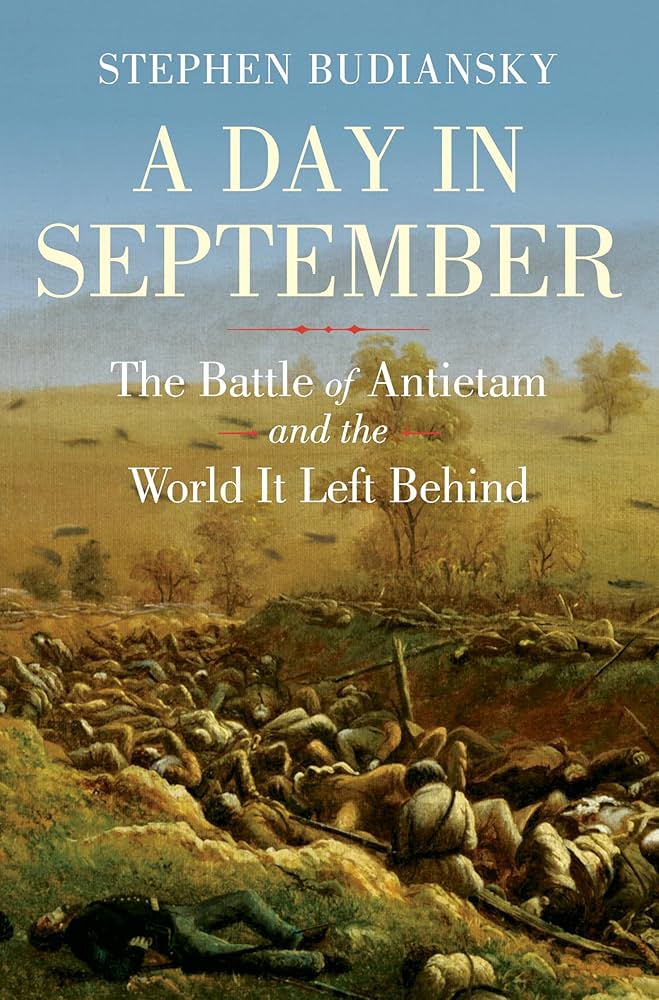Book Review: A Day in September: The Battle of Antietam and the World It Left Behind
A Day in September: The Battle of Antietam and the World It Left Behind. By Stephen Budiansky. W. W. Norton & Company, 2024. Hardcover, 291 pp, $32.50.
Reviewed by Brian Swartz
Author Stephen Budiansky provides a thought-provoking look at Antietam and its decades-long impact on America with his new book, A Day in September: The Battle of Antietam and the World It Left Behind.
Titled “Diverging Rays,” the prologue opens with Dr. Oliver Wendell Holmes traveling from Boston to Antietam to find his wounded son, Oliver Jr. The prologue touches on Antietam’s violence and unspeakable horror (as gleaned from survivors’ letters) and briefly examines cultural, economic, and religious antebellum America to explain how “the coming war would be unremitting, terrible, and fought to the end” and “would fervently be imbued with meaning ever after by those who ‘somehow survived.’” (7)
Doctor Holmes found his namesake son, who decades later told a friend that after Antietam, “The world never seemed quite right again.” (5) Budiansky subsequently develops that point through nine detail-filled chapters.
Each features a particular Antietam participant: Robert E. Lee, George B. McClellan, Jacob Cox, Dr. Jonathan Letterman, Oliver Wendell Holmes Jr., James Longstreet, Alexander Gardner, Clara Barton, and Abraham Lincoln. Their “lives intersected” at Antietam, Budiansky states, and each “emblemizes an aspect of human existence that was changed by what took place there.” (9)
Budiansky could have simply rehashed Antietam lore: he/she came to Sharpsburg and did this-or-that. Instead, he artfully weaves biography (not always back to an individual’s childhood) and history into each individual’s chapter. Lee’s, titled “Who Would be a Soldier,” explains how the future Confederate general became a soldier and why he stayed in the U.S. Army. But the chapter is much more than a Lee biography. Along the way, the reader learns about the West Point Corps of Engineers’ relationship and its effects on America’s pre-war transportation-system development; how European and American military literature impacted Army training and strategy; and the Mexican-American War, during which Lee discovered that “he loved war.” (55) The chapter ends as Lee invades Maryland in September 1862.
I relished Budiansky’s perception of George B. McClellan, whose “fatal combination of hubris and insecurity was at least honestly come by, since they were characteristics of his place and time.” (39) The author puts McClellan against a historical x-ray machine that reveals the flaws plaguing the general whose “contempt for superiors and subordinates alike never wavered.” (41) Both armies are on a Maryland collision course as the chapter unfolds, and as with Lee’s tale, the reader encounters insight and details that Civil War buffs really enjoy.
Though he mentions “my seeming emphasis on the faults and flaws of many of the principal actors” (11) in his book, Budiansky goes easier on Jacob Cox (his chapter highlights infantry tactics, among other aspects); Jonathan Letterman, M.D.; Oliver Wendell Holmes Jr. (the subject of Budiansky’s Oliver Wendell Holmes: A Life, in War, Law, and Ideas); and James Longstreet.
The chapter titled “Laid in Our Dooryard” highlights not so much civilian photographers Alexander Gardner and Matthew Brady, but how their battlefield photographs changed civilian perceptions of war. The chapter also explores battlefield burials and the battle’s long-term effects on Sharpsburg-area residents.
Initially it fells as if Budiansky hyper-criticized Clara Barton in the chapter titled “Woman’s Work.” Then, in re-reading particularly vexatious passages, one realizes that Budiansky had skillfully removed the rose-tinted glasses through which traditional history views Barton. She was a unique woman daring to challenge the status quo, but she was much more complex than the history books indicate. Her chapter also covers in some length the wartime roles (nurses and otherwise) played by American women.
The book ends with Abraham Lincoln (his chapter is titled “Emancipation”) and an epilogue titled “Mists of Memory.” Lincoln’s chapter carries the book’s theme into the 20th century.
A Day in September is compelling reading; each Antietam participant’s tale flows well in clear, concise prose. The book is a “must read” for Antietam buffs.
The only distraction is the lack of footnotes. Believing “I am not doing a serious disservice to readers seeking to track down a particular quotation or fact” (259), Budiansky provides “Notes on Sources,” referred to as “a general description of the sources I used in each chapter.” Finding quotes or facts will require time and effort of a reader or historian.


I was very keen on this new book, thanks to the review, until I saw at the end that it contains no references. I will not be getting this book.
I will be frank. I don’t care if this is “compelling reading.” With all the outstanding SOURCED books now available on so many facets of this campaign, the decision of the author and the publisher to offer nothing more than a simple “Notes on Sources” is lazy and, given the demanding CW audience, deeply disrespectful. It cannot, then, be a “must-read” book.
Smacks of a smash and grab for your wallets. I will never own it, and I will never read it.
This is why I separate my narrative work into novels and my analytical work into histories. I want people to know what they are getting. Conflating the two without disclosing it strikes me as disingenuous.
PS: This is intended as a major stand-alone monograph, akin to “Gleam of Bayonets” by Murfin and “Landscape Turned Red” by Sears. Hence its need for footnotes.
thanks Brian — great review … i am not an “Antietam buff,” but i like the angle the author has taken … Budiansky writes for the popular history market so the no footnotes is no surprise … and often the non-academic publishing houses prefer it that way … thanks again, enjoyed your review.